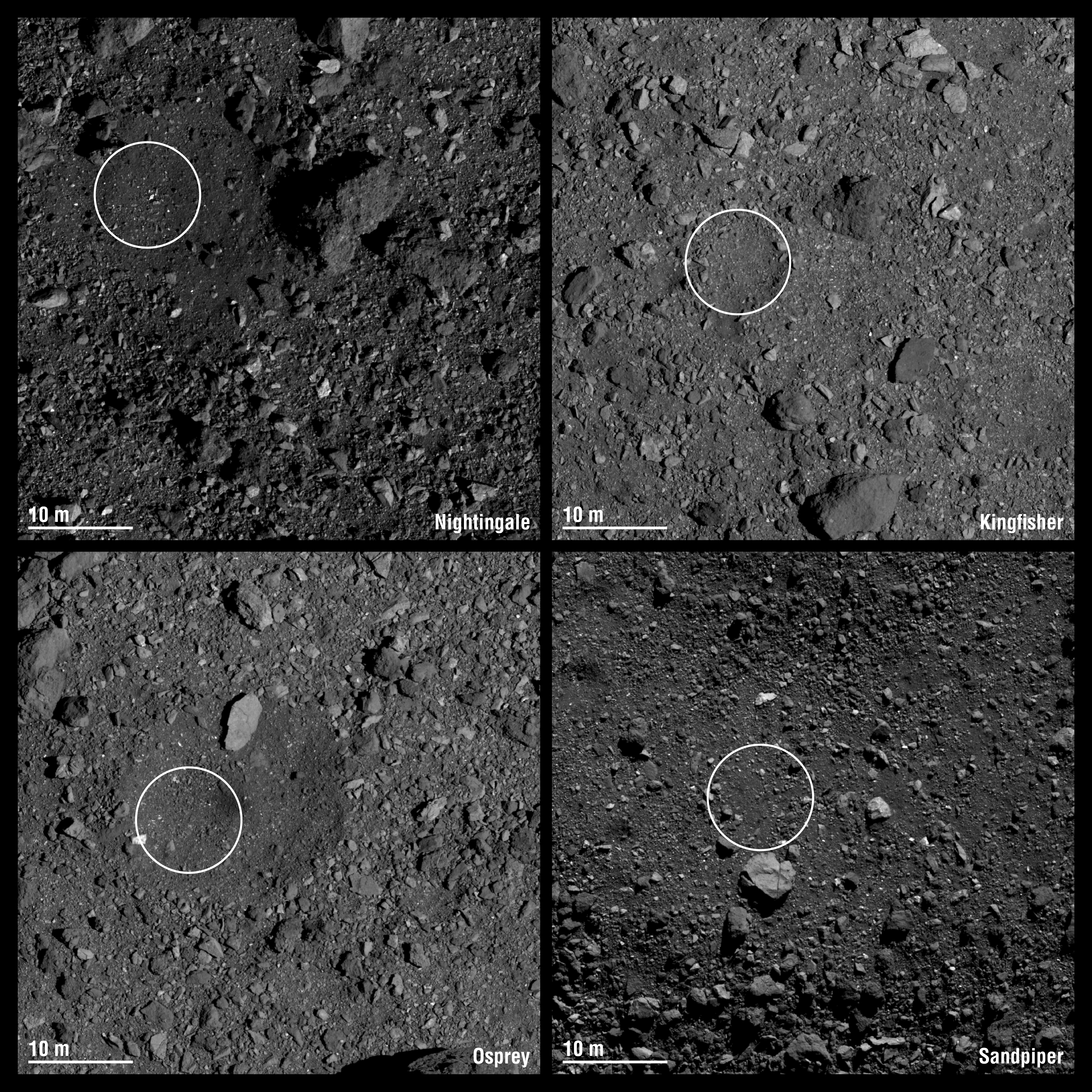A NASA Spacecraft Will Snatch Samples of Asteroid Bennu in 2020. Here's 4 Places It May Land
When a NASA spacecraft makes its move to grab a piece of space rock in 2020, will it snatch at a sample of a dark, sandy Nightingale or of a very wet Kingfisher?
It's still too early to say. But after more than eight months of sizing up an asteroid called Bennu, the team behind the OSIRIS-REx spacecraft has selected four sites on the space rock's surface as possible sampling sites. Selecting those candidate sites was more challenging than the mission staff had hoped before they got a close look at the asteroid, which is much rockier than it appeared from a distance. All those rocks made it challenging to find sites that didn't risk damaging the spacecraft.
"Although OSIRIS-REx was designed to collect a sample from an asteroid with a beach-like area, the extraordinary in-flight performance to date demonstrates that we will be able to meet the challenge that the rugged surface of Bennu presents," Rich Burns, OSIRIS-REx project manager at NASA's Goddard Space Flight Center in Maryland, said in a statement.
Related: OSIRIS-REx: NASA's Asteroid Sample-Return Mission in Pictures

More formally known as the Origins, Spectral Interpretation, Resource Identification, Security-Regolith Explorer, the spacecraft nicknamed OSIRIS-REx arrived at the asteroid Bennu in December 2018, slipping into orbit at the close of that year. Since then, it has mapped the asteroid's rocky surface in great detail in order to inform the selection of the sampling sites.
The spacecraft is designed to sample materials less than 1 inch (2.5 centimeters) across. Before the mission left for its exotic destination, the team was expected to find large areas of fine-grained material, which would permit relatively straightforward sampling. But even early in the spacecraft's journey, its photographs suggested that Bennu was covered in rocks — complicating that sampling procedure dramatically.
"We knew that Bennu would surprise us, so we came prepared for whatever we might find," Dante Lauretta, OSIRIS-REx principal investigator at the University of Arizona, said in a statement. "As with any mission of exploration, dealing with the unknown requires flexibility, resources and ingenuity."
Get the Space.com Newsletter
Breaking space news, the latest updates on rocket launches, skywatching events and more!
Some of that flexibility has meant allotting extra time to the sampling-site selection process. The mission's original timeline had planned for the team to be settled on its two final site contenders by now, but also included 10 months of time to be allocated to challenges as they arose.
The engineers behind OSIRIS-REx also had to develop a new sampling approach, which they're calling "Bullseye TAG," to sample with higher precision. That technique means that rather than needing boulder-free sites 82 feet (25 meters) across — which turn out not to exist on Bennu — the spacecraft will be able to target sites that are just 16 to 33 feet (5 to 10 meters) across instead.
And the OSIRIS-REx experts have selected four such sites to inspect more closely this fall. Each area has been given the nickname of a bird species found in Egypt, a nod to the International Astronomical Union's decision that official names for features on the asteroid should refer to birds in mythology.
The site dubbed Nightingale is tucked into a crater within a crater and sports the darkest, most fine-grain material of the areas the team has selected. A much smaller crater closer to Bennu's equator and ringed by boulders holds the second potential site, Kingfisher, which appears most likely to host hydrated minerals, which would have formed in the presence of water. Osprey is located at a similar latitude and also within a small crater, and appears to hold the most carbon-rich rock. A relatively large crater in Bennu's southern hemisphere holds the Sandpiper site, which may also have water-rich rock.
Now that the team has its contenders, the spacecraft will conduct more-detailed analysis of the sites from less than a mile above the space rock's surface. During that analysis, the team will aim to confirm that each site is safe for the spacecraft and holds material that the sampling apparatus should be able to successfully process.
The OSIRIS-REx team will select a final sampling site and a backup site in December and perform the sampling maneuver in the second half of next year. Scientists will finally get their hands on the collected material in September 2023.
- Zoom! Asteroid Bennu Slips Past in OSIRIS-REx Flyby View
- As the Asteroid Turns: NASA Probe Snaps Video of Spinning Bennu
- Asteroid Bennu Goes Technicolor in 3-D NASA View
Email Meghan Bartels at mbartels@space.com or follow her @meghanbartels. Follow us on Twitter @Spacedotcom and on Facebook.
Join our Space Forums to keep talking space on the latest missions, night sky and more! And if you have a news tip, correction or comment, let us know at: community@space.com.

Meghan is a senior writer at Space.com and has more than five years' experience as a science journalist based in New York City. She joined Space.com in July 2018, with previous writing published in outlets including Newsweek and Audubon. Meghan earned an MA in science journalism from New York University and a BA in classics from Georgetown University, and in her free time she enjoys reading and visiting museums. Follow her on Twitter at @meghanbartels.









